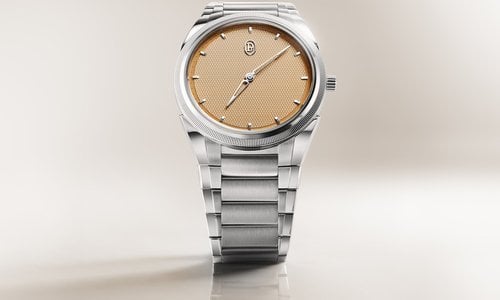Unveiled in 2012, the Clock 15 days lays bare the stark architecture of its movement and the beauty of its transparent finish behind five rock crystal panels. Keen to augment the considerable aesthetic beauty of this piece, Parmigiani Fleurier has joined forces with Lalique, experts in fine crystal work, to create an exclusive limited edition version featuring a Lalique crystal to enhance the clock’s exquisite contours.
For Parmigiani Fleurier, this table clock represents gigantic dimensions, particularly in terms of its mechanics. Accustomed to minuscule watch components, the watchmakers at Parmigiani Fleurier had to shift their focus to a larger order of magnitude and, as a result, relearn much of their craft. To work standing up rather than sitting down, to swap tweezers for fingers, and reliance on the watchmaker’s magnifier rather than the naked eye. Most important was rediscovering the “pure movement” for each operation – the trademark dexterity that enables the watchmaker to achieve the perfect finish. As the dimensions increase, the tactile memory no longer applies... we must therefore go in search of a new pure movement – a rare and magnificent adventure – to develop a subtle touch suited to a world of giants.
For Lalique, the challenge of this project was precisely the opposite: the surfaces of the clock’s five panels are much smaller and thinner than the threshold generally tolerated for working crystal. This delicate art, at which Lalique excels, requires the subtle alternation of heating and cooling to produce a pure crystal with no air bubbles. Working crystal of minimal thickness, as required for the panels of the Clock 15 days is no mean feat.
-

- The limited-series Lalique version of the Parmigiani Fleurier 15-day clock
The crystal is adorned with Lalique’s characteristic motif: the Coutard fountain. Invented by René Lalique in 1935, this panel design, which represents a spray of water droplets, is reminiscent of both Art Nouveau in the close arrangement of the drops and Art Deco in their rounded shape. The end of each droplet is worked to achieve an exceptional shine, creating an extraordinary contrast with the satin-finished crystal on its flat surface.
A powerful symbol of life and rebirth, here the Coutard fountain is associated with an ageless Table Clock – a reminder that the possibilities for reviving the great classics are truly limitless. In addition to its aesthetic beauty, the tour de force of this clock is mechanical – in an ingenious piece of workmanship, the Maltese cross stopwork for the power reserve indicator is located on the outside. This is a patented innovation.
Governing the winding of the barrel, and counting its rotations, the Maltese cross is a fundamental part of the power reserve in all timepieces. But it had not yet been used directly to display the power reserve status. Previously, several mechanical devices and setting wheels acted as intermediaries. By choosing to externalise this Maltese cross and to display the movement on the barrel itself, the Parmigiani Fleurier watchmakers found an elegant solution to this dilemma that is, mechanically speaking, both simpler and more direct.
The scale and the display for this power reserve are repeated around the barrel at a 90° angle, thanks to a hand with four arms; thus four successive indications ensure that this information is always visible, whether or not the barrel is fully wound.
Source: Parmigiani Fleurier




